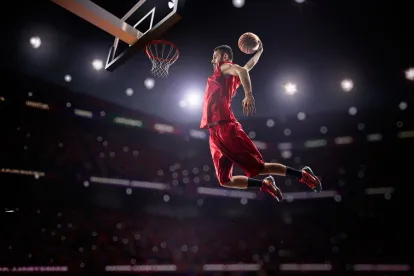In a dispute concerning the famous Michael Jordan “Jumpman” logo owned by Nike, Inc., the US Court of Appeals for the Ninth Circuit agreed with the district court that the Nike logo did not infringe any copyright in photographer Jacobus Rentmeester’s 1984 photograph of Michael Jordan after Nike commissioned its own photo of Jordan, which was then used to create the Jumpman logo. Jacobus Rentmeester v. Nike, Inc., Case No.15-35509 (9th Cir., Feb. 27, 2018) (Watford, J) (Owens, J, concurring in part, dissenting in part).
One of Nike’s most recognizable trademarks, the Jumpman logo, was created in 1987 when Nike commissioned a photograph of then-Chicago Bulls player Michael Jordan to create the now-famous solid color silhouette design of Jordan soaring in the air toward a slam dunk. According to Rentmeester’s complaint for copyright infringement, both the Jumpman logo and the commissioned photograph used to create the logo infringe Rentmeester’s own 1984 photograph of Jordan, which originally appeared in a Life magazine photo essay featuring Olympic athletes.
Rentmeester’s photograph is famous in its own right. The photograph was choreographed by Rentmeester and depicts Jordan in a ballet-inspired leap rising toward an out-of-reach basketball hoop placed on a grassy knoll, contrasted against a bright blue sky. After the Rentmeester photo appeared in Life magazine, and right around the time that Nike was partnering with Jordan in connection with the Air Jordan athletic shoe, Rentmeester licensed two transparencies of his Jordan photograph to Nike “for slide presentation only.” The creation of Nike’s Jumpman logo occurred shortly thereafter.
Although Nike has been using the Jumpman logo for 30 years, Rentmeester filed his action for copyright infringement in 2015. To avoid a defense of laches, Rentmeester sought damages only for acts of infringement for the preceding three years, as allowed under the Copyright Act. After the district court granted Nike’s motion to dismiss, concluding that neither Nike’s commissioned photo of Jordan nor the Jumpman logo infringed Rentmeester’s copyright as a matter of law, Rentmeester appealed.
Reviewing the district court’s decision de novo, the Ninth Circuit explained that the only relevant issue on appeal was whether Nike engaged in unlawful appropriation by copying more of Rentmeester’s protected expression in his 1984 photo than copyright law allows. In analyzing that issue, the Court walked through the various elements and tests for proving copyright infringement.
To state a claim for copyright infringement in a photograph, a plaintiff must plausibly allege that (1) it owns a valid copyright and (2) the defendant copied protected aspects of the photo’s expression. The second element, however, has two distinct components: “copying” and “unlawful appropriation.” Each of these elements requires a showing of “substantial similarity” between the works at issue. Substantial similarity constituting unlawful appropriation must involve the copying of enough protected elements of the plaintiff’s work, such as the particular expression of ideas or concepts.
Under this framework, the Ninth Circuit found that Rentmeester plausibly alleged (1) ownership of a valid copyright in the 1984 photo, and (2) copying of the photo by Nike, given Nike’s access to the original Rentmeester photo, as well as various conceptual similarities between the works. Nevertheless, the Court determined that Rentmeester did not plausibly allege that Nike copied enough of the protected expression from the 1984 photo to establish unlawful appropriation.
The Ninth Circuit outlined the “extrinsic test” used by courts to assess the objective similarities of two works as a matter of law, which requires the “filtering out” of unprotectable elements of the plaintiff’s work, such as ideas, concepts and materials in the public domain, before comparing the remaining protectable elements to the allegedly infringing work. The Court noted that the dissection and comparison of photographs can be challenging given that individual elements of a photograph, such as the subject matter, a pose or a camera angle, are not protectable standing alone. Instead, what is protected is the photographer’s selection and arrangement of those otherwise unprotected elements.
In comparing the Rentmeester photo to the photograph commissioned by Nike, the Ninth Circuit determined that the works were not substantially similar as a matter of law, concluding that each photographer made a “series of creative choices in the selection and arrangement of the elements in his photograph” to produce images that differ from one another in “more than just minor details.” The Court noted that while the photos embody a similar idea or concept (a basketball player in a leaping, ballet-inspired pose moving toward a hoop in an outdoor setting captured by a camera angle to create a silhouette against the sky), the two photographs express that concept through objective details in “different ways.”
Affirming the district court and holding that the Jordan photograph commissioned by Nike could not, as a matter of law, be found substantially similar to Rentmeester’s photo, the Ninth Circuit applied that same conclusion to Nike’s corresponding Jumpman logo, which the Court noted is “even less similar” to the Rentmeester’s photo.
In partial dissent, Judge Owens agreed with the holding as it was applied to the Jumpman logo, but disagreed with the holding as to the commissioned Nike photo, arguing that questions of substantial similarity are inherently factual and should not be decided by a motion to dismiss.




 />i
/>i

